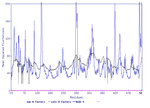Difference between revisions of "Normal mode analysis HEXA"
From Bioinformatikpedia
(→Results) |
(→Results) |
||
| Line 102: | Line 102: | ||
Here you can see the CA distance fluctuations for the different modes:<br><br> |
Here you can see the CA distance fluctuations for the different modes:<br><br> |
||
| − | This matrix displays the maximum distance fluctuations between all pairs of CA atoms and between |
+ | This matrix displays the maximum distance fluctuations between all pairs of CA atoms and between |
| + | the two extreme conformations that were computed for this mode (DQMIN/DQMAX). Distance increases are |
||
| − | plotted in blue and decreases in red for the strongest 10% of the residue pair distance changes. Every pixel corresponds to a single residue. Grey lines are drawn every 10 residues, yellow lines |
||
| + | plotted in blue and decreases in red for the strongest 10% of the residue pair distance changes. |
||
| + | Every pixel corresponds to a single residue. Grey lines are drawn every 10 residues, yellow lines |
||
every 100 residues (counting from the upper left corner). |
every 100 residues (counting from the upper left corner). |
||
Revision as of 12:52, 14 July 2011
Contents
Webnma
General information
Results
We analysed the five models with the lowest energy values. Webnma calculates fourteen different models with following energy values:
| Mode Index | Deformation Energy |
| 7 | 1041.88 |
| 8 | 1318.21 |
| 9 | 1738.30 |
| 10 | 2841.31 |
| 11 | 3135.09 |
| 12 | 4100.18 |
| 13 | 3911.06 |
| 14 | 5337.50 |
| 15 | 5741.69 |
| 16 | 6513.85 |
| 17 | 6081.05 |
| 18 | 6882.96 |
| 19 | 7514.14 |
| 20 | 7943.67 |
We took the first five models (7, 8, 9, 10, 11).
Here you can see the normalized squared atomic displacments of our models:
| model 7 | model 8 | model 9 | model 10 | model 11 |
Here you can see the motion of our analyses.
| model 7 | model 8 | model 9 | model 10 | model 11 |
Discussion
El Nemo
General information
Results
Here you can see the CA distance fluctuations for the different modes:
This matrix displays the maximum distance fluctuations between all pairs of CA atoms and between the two extreme conformations that were computed for this mode (DQMIN/DQMAX). Distance increases are plotted in blue and decreases in red for the strongest 10% of the residue pair distance changes. Every pixel corresponds to a single residue. Grey lines are drawn every 10 residues, yellow lines every 100 residues (counting from the upper left corner).
Discussion
Anisotropic Network Model web server
General information
Results
Here you can see the B-factor distribution of the real occuring B-factors (black) and the calulated B-factors (blue).
| model 1 | model 2 | model 3 | model 4 | model 5 |
In the next table, the motion of the protein of the different models is shown:
| model 1 | model 2 | model 3 | model 4 | model 5 |
Discussion
NOMAD-Ref
General information
Results
| model 1 | model 2 | model 3 | model 4 | model 5 |
| model 1 | model 2 | model 3 | model 4 | model 5 |
All-atom NMA using Gromacs on the NOMAD-Ref server
General information
Results
600K
Here you can see the motion of 1BPT at temprature 600K.
| model 7 | model 8 | model 9 |
2000K
Here you can see the motion of 1BPT at temprature 2000K.
| model 7 | model 8 | model 9 |



































